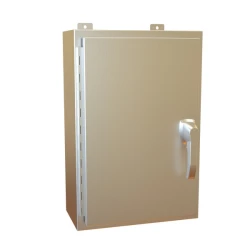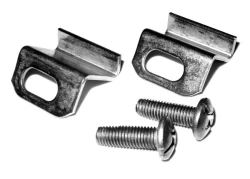Electrical Enclosures
Our knowledgable group at Control Design Supply can help you find the perfect panel to suit your needs. Whether you need a slopped top, a glass window, or a lockable handle on your panel, we can guide you to the right part. Contact us anytime with your questions or for more information on our products!
What to Consider to Select the Right Electrical Enclosure
Material and Construction
-
Electrical enclosures are typically constructed from materials such as metal (steel, stainless steel, aluminum), fiberglass, or polycarbonate. The choice of material depends on factors such as environmental conditions, corrosion resistance, and specific application requirements.
NEMA and IP Ratings
-
Enclosures are often rated according to National Electrical Manufacturers Association (NEMA) standards or Ingress Protection (IP) ratings. NEMA ratings indicate the level of protection against environmental factors, while IP ratings specify the degree of protection against dust and water ingress.
Door and Latch Mechanisms
-
Doors on electrical enclosures may feature various latching mechanisms, including handles, locks, and hinges. Secure latching ensures that the enclosure remains closed, protecting against unauthorized access and environmental elements.
Ventilation and Cooling
-
Some enclosures include ventilation features, such as louvers or fans, to dissipate heat generated by enclosed electrical components. Ventilation helps maintain optimal operating temperatures and prevents overheating.
Gasket Seals
-
Gasket seals are used to create a tight seal between the enclosure's components, preventing the entry of dust, water, or other contaminants. The quality of gasket seals contributes to the enclosure's environmental protection capabilities.
Mounting Provisions
-
Enclosures are designed with mounting provisions for electrical components, devices, and accessories. Mounting options may include panels, DIN rails, or other fixtures to secure equipment within the enclosure.
Back Panels and Subpanels
- Many enclosures come with back panels or subpanels to support the mounting of devices and facilitate organization within the enclosure. Back panels also provide additional structural support.
Cable Management
- Enclosures often include features for organized cable entry and management. Cable glands entry plates, and conduit connections help maintain a neat and efficient wiring layout.
Modularity and Customization
- Some enclosures are modular, allowing for the addition or removal of panels, shelves, or accessories to accommodate changing requirements. Customization options may include cutouts for connectors, windows for visual inspection, and specific configurations based on application needs.
Key Functions of Industrial Electrical Panels:
- Power Distribution: Industrial electrical panels receive power from the main incoming supply and then distribute it across various circuits to different machines or areas of the facility. This could include everything from motors running conveyors to control circuits for safety systems.
- Overload Protection: Industrial panels often include circuit breakers or fuses that protect equipment from electrical overloads or faults. These breakers automatically shut off the power when an issue is detected, preventing damage to both the equipment and the wiring.
- Control and Automation: In industries with automated systems, electrical panels house controls for those systems. For example, programmable logic controllers (PLCs) or variable frequency drives (VFDs) may be installed in the panel to control the speed and operation of motors or to monitor and adjust system parameters in real time.
- Monitoring and Safety: Panels are often equipped with meters, alarms, and monitoring systems that keep track of electrical usage, voltage, and current. These systems can alert operators to potential problems before they cause a shutdown or safety hazard. Safety features are critical, as many industrial settings deal with high-voltage systems or dangerous machinery.
- Subpanels and Branch Circuits: Larger facilities might have subpanels, which are smaller panels connected to the main one to help distribute power to different sections of the plant. These subpanels help to reduce the load on a single panel and can be used to isolate different areas of the plant for maintenance or in case of an emergency.
Common Applications for Electrical Enclosures
- Industrial Control Panels: Enclosures house control panels that manage and control industrial processes.
- Electrical Distribution: Enclosures are used in electrical distribution systems to house circuit breakers, distribution boards, and other components.
- Automation Systems: Enclosures protect PLCs (Programmable Logic Controllers) and other automation components in manufacturing and industrial automation settings.
- Instrumentation: Enclosures safeguard sensitive instrumentation and measurement devices from environmental factors.
- Outdoor Installations: Weatherproof enclosures are used in outdoor installations to protect electrical equipment from rain, snow, and sunlight.
- Data Centers: Enclosures house servers, switches, and other critical equipment in data center environments.
Electrical enclosures play a vital role in maintaining the integrity and reliability of electrical systems across various industries. Proper selection and installation of enclosures are essential to ensure the safety of personnel, protect equipment, and comply with regulatory standards.
Order Your Enclosures from CDS Today!
With over five decades of industry experience, we are a trusted and leading supplier of electronic components. Our large inventory of electrical products is designed to provide solutions for every industry. In addition to top-quality electrical components, we offer comprehensive kitting, assembly, and customization services to meet your exact needs. No matter your project or specifications, you can find the right solution at CDS.Contact us to learn more about our products and services and speak with a knowledgeable team member. Request a quote to get started on your order today.






